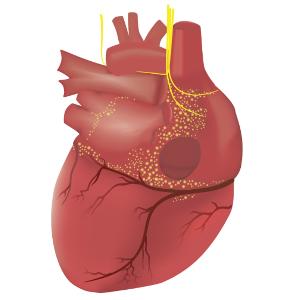Unraveling the Heartbeat
23 May 2024
Konstantin Hennis and Christian Wahl-Schott review the latest findings on the automaticity of the sinus node and the role of pacemaker channels.
23 May 2024
Konstantin Hennis and Christian Wahl-Schott review the latest findings on the automaticity of the sinus node and the role of pacemaker channels.

In yellow: nerve fibers, ganglia and plexuses of the autonomic and the intrinsic cardiac nervous system. | © Hennis et al., Circulation Research 2024
In the journal Circulation Research, Konstantin Hennis and Christian Wahl-Schott review the latest findings on the automaticity of the sinus node and discuss the physiological and pathophysiological role of pacemaker channels.
The chronotropic response is a complex physiological process by which heart rate is adapted to changing physical needs. Loss or dysregulation of the normally precise control of heart rate by the autonomic nervous system plays a critical role in the development and progression of cardiovascular disease, including ischemic heart disease, heart failure and arrhythmias. Heart rate acceleration and deceleration are mediated by increasing or decreasing the spontaneous firing rate of pacemaker cells in the sinus node. During the transition from rest to activity, sympathetic neurons stimulate these cells by activating β-adrenergic receptors and increasing intracellular cyclic adenosine monophosphate (cAMP). While the clinical importance of regulating changes in heart rate, known as the chronotropic effect, is undeniable, the mechanisms that ultimately control these changes at the molecular level are not yet fully understood.
In their review, Konstantin Hennis, Christian Wahl-Schott and colleagues look at the importance of HCN pacemaker channels in the adaptation of heart rate under healthy and pathological conditions. The so-called pacemaker channels are involved in the rhythmic excitation of special heart cells and neurones. Their comprehensive analysis is based on over 230 in vivo and in vitro studies in different mammalian species and humans, as well as modelling studies. Special emphasis was placed on demonstrating the relationships between the physiology and pathophysiology in humans and other mammals, and formulating conclusions that are generally applicable to humans.
Only recently, it has become more recognized that nonfiring or dormant pacemaker cells exist in the sinus node and play an important role during the chronotropic response. Regulation of pacemaker channels by cAMP contributes to controlling the number of nonfiring cells rather than changing the frequency of firing cells.
In this review the authors conclude that pacemaker channels do not substantially contribute to the frequency-increasing effect of the chronotropic response, while they do control other important aspects of chronotropy such as stabilization of basal heart rate and heart rate transitions as well as dampening and balancing the input of the autonomic nervous system. Taken together, this defines a new concept for the role of HCN pacemaker channels in sinus node function and expands our understanding of the molecular and cellular mechanisms required for precise heart rate control.
Konstantin Hennis et al: Pacemaker Channels and the Chronotropic Response in Health and Disease, Circulation Research. 2024